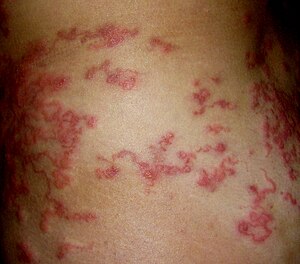Cutaneous larva migrans
| Cutaneous larva migrans | |
|---|---|
 |
|
| Typical "creeping eruption" associated with cutaneous larva migrans | |
| Classification and external resources | |
| Specialty | infectious disease |
| ICD-10 | B76.9 |
| ICD-9-CM | 126.9 |
| DiseasesDB | 3263 |
| MedlinePlus | 001454 |
| eMedicine | derm/91 ped/1278 |
| MeSH | D007815 |
Cutaneous larva migrans (abbreviated CLM) is a skin disease in humans, caused by the larvae of various nematode parasites of the hookworm family (Ancylostomatidae). The most common species causing this disease in the Americas is Ancylostoma braziliense. These parasites live in the intestines of dogs, cats, and wild animals and should not be confused with other members of the hookworm family for which humans are definitive hosts, namely Ancylostoma duodenale and Necator americanus.
Colloquially called creeping eruption due to its presentation, the disease is also somewhat ambiguously known as "ground itch" or (in some parts of the Southern USA) "sandworms", as the larvae like to live in sandy soil. Another vernacular name is plumber's itch. The medical term CLM literally means "wandering larvae in the skin".
Hookworm eggs are shed in infected dog (or other animal) feces to the ground and beach sand, where they then develop over a period of 1–2 weeks into the infectious larval form (filariform larvae). The filariform larvae can burrow through intact skin that comes into contact with soil or sand that is contaminated with feces. Although they are able to infect the deeper tissues of animals (through to the lungs and then the intestinal tract), humans are incidental hosts and the larvae are only able to penetrate the epidermis of the skin and thus create the typical wormlike burrows visible underneath the skin. These parasites apparently lack the collagenase enzymes required to penetrate through the basement membrane deeper into the dermal layers of the skin.
The infection causes a red, intensely pruritic (itchy) eruption. The itching can become very painful and if scratched may allow a secondary bacterial infection to develop. Cutaneous larva migrans usually heals spontaneously over weeks to months and has been known to last as long as one year. However, the severity of the symptoms usually causes those infected to seek medical treatment before spontaneous resolution occurs. Following proper treatment, migration of the larvae within the skin is halted and relief of the associated itching can occur in less than 48 hours (reported for thiabendazole).
...
Wikipedia
